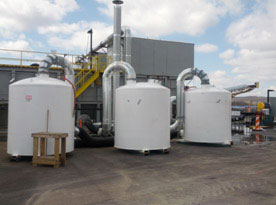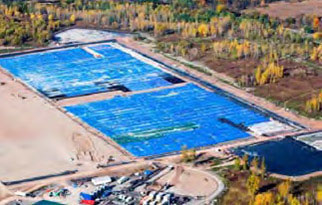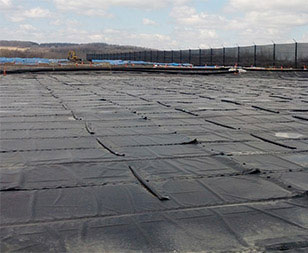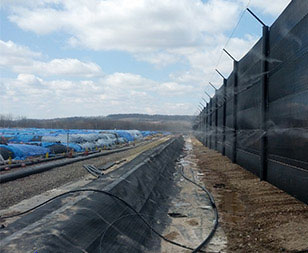Honeywell has completed the dredging and capping of Onondaga Lake. Dredging was completed in November 2014, a year ahead of schedule. Capping was completed in December 2016. The sediment cap, which creates a new, clean lake bottom, consists of more than 3 million cubic yards of natural materials placed over 475 acres of the lake bottom. Construction of the cover system for the consolidation area, which holds material removed from the lake, was completed in 2017. Covering and capping the consolidation area began in spring 2015 to permanently isolate drying lake material. The cap consists of layers of soil, a plastic liner sealed around the entire perimeter, and additional protective layers of soil and vegetation. In 2016, a polyethylene liner and soil were put in place to permanently encapsulate the geotextile tubes. The top has been planted with native grasses and vegetation.
System Designed to Protect Air Quality and Minimize Odors; Air Monitoring Results Significantly Below State-Established Site Criteria
Honeywell has completed the consolidation area under the supervision, and at the direction of, federal and state regulatory agencies.
A key part of the cleanup is the Community Health and Safety Plan, which was reviewed by the New York State Department of Environmental Conservation (DEC), the U.S. Environmental Protection Agency (EPA), and the New York State Department of Health (DOH), and approved by DEC.
In June 2010, EPA released its human health risk assessment, which looked at “potential health impacts to people who live near the facility which will contain sediments removed from the lake and determined that all resulting risk and hazard estimates were within the range or below levels identified by EPA as acceptable.”
According to DEC, “total VOC levels detected at the perimeter monitoring locations comply with the standard established for protecting public health.”
Even though the potential for odors was greatly reduced after dredging, Honeywell maintained odor control measures, where appropriate. Sealant was reapplied as appropriate to the drying geotube bags, misting systems operated, and large fans run depending on wind direction, wind speed, and weather conditions such as temperature and precipitation.
Water storage basins have been cleaned and are no longer used to hold water from drying bags.
The potential for odors has been further reduced since completion of the consolidation area cover system. Odors are checked once per week by trained professionals at the eight fixed air monitoring stations along the work perimeter of the consolidation area.
Air Quality Monitoring Protects Health and Safety
Short-term real-time air monitoring for total volatile organic compounds (TVOCs) and dust monitoring are now complete. Long-term air monitoring for individual VOCs (referred to as speciated VOCs) is also complete. For more information about the air monitoring program see here.
Operations Continuously Improved in 2012, 2013, and 2014
Over the course of dredging activities, Honeywell looked to continuously improve operations to minimize, to the extent possible, potential off-site odors. Several actions were taken to improve odor controls.
In September 2012, we took the following actions to improve odor controls:
- Installed the misting system
- Significantly reduced temporary standing water in the active water basin
- Installed a cover system for active work areas in the water basin
- Enhanced the capture of vapors from the thickeners by installing a stand-alone carbon filtration system
- Covered geotextile bags with plastic when full. (This practice was superseded by a more effective covering process developed in 2013.)
Although these mitigation measures were effective, in fall 2012 and winter 2013 some odors were reported. While air quality at the work site perimeter continued to comply with the standards established for protecting public health, DEC and Honeywell worked with engineers, scientists, and odor experts from across the country during the winter to identify additional measures to further reduce the potential for odors.
In 2013, the following additional measures were deployed:
- Substantial upgrades to geotube cover system:
- An alternative cover system was developed that is integrated into the geotubes’ manufacturing process. A prototype was successfully tested, and unused geotubes were sent back to the manufacturer for retrofitting.
- Covers over channels between the geotubes
- Applying a sealant on drying geotube bags to more effectively minimize emissions and improve worker safety by reducing the potential for worker slips, trips and falls on site
- Enhanced water management to reduce the flow of water to the geotubes
- Improvement and expansion of the misting system to intercept potential odors
- Containment during transportation and stockpiling of oversized material to reduce potential odors
- Windscreens to enhance the performance of the misting systems by interrupting airflow from the sediment dewatering area
- Installed fans along the northern work site perimeter to increase air flow
|
|
Building on the system upgrades, which were implemented in the previous dredging seasons and proven to be effective, DEC and Honeywell continued evaluating additional measures to further reduce potential odors.
In 2014, the following additional measures were deployed:
- Installed additional fans along the western work site perimeter
- Increased the height of the misting system along the western work site perimeter









